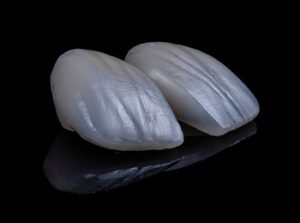In cosmetic dentistry, porcelain veneers are a trending solution for achieving a radiant, flawless smile. They offer remarkable versatility, durability, and aesthetic appeal. However, the concern often arises: do porcelain veneers stain? In this comprehensive guide, we delve into the intricacies of porcelain veneers, exploring whether they stain, the causes behind staining, preventive measures, and solutions if staining occurs.
Understanding Porcelain Veneers
Porcelain veneers are ultra-thin shells crafted from medical-grade porcelain. They are custom-made to fit over the front surface of natural teeth, effectively masking imperfections and enhancing the overall appearance of one’s smile. Unlike natural tooth enamel, porcelain veneers resist stains and maintain their brightness and lustre over time.
Do Porcelain Veneers Stain?
One of the primary merits of porcelain veneers is their stain-resistant nature. However, while the veneers resist staining, the natural tooth underneath does not. Besides, porcelain veneers may discolour. Thus, maintaining good oral hygiene and avoiding stain-causing substances is crucial for preserving the appearance of the veneers and the natural teeth.
Why Porcelain Veneers Look Stained
Understanding the underlying factors contributing to porcelain veneer staining is crucial for implementing effective preventive measures. While porcelain veneers are highly resistant to permanent stains, several external factors can compromise their appearance over time.
Poor Dental Hygiene
Inadequate oral hygiene habits, such as irregular brushing and flossing, can accumulate plaque and tartar on the surfaces of both natural teeth and veneers. This buildup detracts from the smile’s aesthetic appeal and provides a conducive environment for stain-causing substances to adhere.
Consumption Of Stain-Causing Substances
Certain foods and beverages contain pigments that can penetrate the porous surface of porcelain veneers, resulting in discolouration. Common culprits are coffee, tea, red wine, and dark-coloured fruits and vegetables. Additionally, acidic foods and drinks can damage the protective layer of natural tooth enamel, making it more susceptible to staining.
Smoking
Gum Disease And Gum Recession
Periodontal issues such as gum disease and gum recession can expose the vulnerable areas of natural teeth and veneers to staining agents. As the gum tissue recedes, the root surfaces of the teeth become more susceptible to discolouration, detracting from the overall aesthetics of the smile.
Prevention Of Tooth Stains Underneath Porcelain Veneers
While porcelain veneers are inherently resistant to stains, proactive measures can help maintain their pristine appearance:
Practise Good Oral Hygiene
Plaque accumulation and surface discolouration may be avoided with regular brushing and flossing. Clean your teeth regularly with non-abrasive toothpaste and a soft-bristle toothbrush.
Limit Stain-Causing Substances
Cut back on the coffee, tea, red wine, and dark-coloured sauces that might discolour your teeth. Consider using a straw to limit contact with the veneers when eating these things.
Quit Smoking
Smoking poses serious health risks and accelerates the staining process of natural teeth and discolouration of porcelain veneers. Quitting smoking can significantly improve the appearance and longevity of dental restorations.
Attend Professional Teeth Cleaning
Professional dental cleaning sessions are crucial for monitoring the condition of natural teeth and veneers. Professional cleanings can remove surface stains and plaque buildup, ensuring the longevity of your smile.
What To Do When You Have Stained Porcelain Veneers
When staining is severe or irreversible, the veneers may need to be replaced. Your dentist can create new veneers that match the shape of your natural teeth, rejuvenating your smile.
Porcelain Veneers Vs. Composite Veneers: Stain-Resistance Comparison
When considering dental veneer options, it’s essential to understand the differences between porcelain and composite veneers, particularly their stain-resistant properties.
While both types of veneers can enhance the appearance of your smile, porcelain veneers offer several advantages over their composite counterparts in terms of stain resistance.
Composition
Porcelain veneers are crafted from high-quality medical-grade porcelain material, renowned for its exceptional durability and stain-resistant properties.
The dense, non-porous surface of porcelain makes it highly resistant to external staining agents, ensuring that your smile remains vibrant and radiant.
In contrast, composite veneers are made from a resin material more susceptible to staining. Although composite veneers can be polished to a smooth finish, their porous nature allows pigments from foods, beverages, and tobacco products to penetrate the surface, leading to discolouration over time.
Surface Finish
Porcelain veneers are meticulously fabricated in a dental laboratory to achieve a smooth, glass-like surface finish. This smooth surface enhances the smile’s aesthetics and inhibits the adhesion of stain-causing substances. As a result, porcelain veneers maintain their brightness and lustre, even when exposed to staining agents.
On the other hand, composite veneers may develop surface roughness over time, creating microscopic irregularities where stains can accumulate.
Despite efforts to polish composite veneers to a high shine, the material’s inherent porosity makes them more prone to staining, detracting from their aesthetic appeal.
Longevity
Porcelain veneers are renowned for their exceptional longevity. Many patients enjoy their enhanced smile for a decade or more with proper care. The stain-resistant properties of porcelain ensure that your veneers retain their pristine appearance, even with regular exposure to stain-causing substances.
While composite veneers offer a more affordable alternative to porcelain, they typically have a shorter lifespan and may require more frequent maintenance and replacement.
Composite material’s susceptibility to staining can diminish aesthetics, necessitating additional procedures to restore the smile’s appearance.
Frequently Asked Questions
Can porcelain veneers be whitened with a whitening toothpaste?
No, regular dental whitening treatments cannot effectively whiten porcelain veneers. Porcelain material might change colour when exposed to whitening agents without protection.
How do I prevent stains on porcelain veneers?
To prevent stains on porcelain veneers, practise good oral hygiene, limit consumption of stain-causing substances, quit smoking, and attend regular dental check-ups for professional cleanings.
Do porcelain veneers stain easily?
Porcelain veneers are inherently resistant to stains. However, maintaining good oral hygiene and avoiding stain-causing substances can help preserve their appearance over time.
Repairing Your Porcelain Veneers
By practising good oral hygiene, limiting exposure to stain-causing substances, and seeking professional dental care, you can enjoy a radiant smile for years.
If staining occurs, rest assured that effective solutions are available to restore the beauty of your porcelain veneers.
Contact Casey Dentists, Aitkenvale (Townsville) Queensland, 4814, at 07 4801 7035 to learn whether you need whiter porcelain veneers.
Sources:
Abdalkadeer, Hadeel K., et al. “Influence of the Coca-Cola Drinks on the Overall Color of Glazed or Polished Porcelain Veneers Fabricated From Different Materials and Thicknesses: An in Vitro Study.” The Journal of Contemporary Dental Practice, vol. 21, no. 1, Jan. 2020, pp. 56–61. https://doi.org/10.5005/jp-journals-10024-2705.
Kara, Haluk Barış, et al. “The Effect of Bleaching Agents on the Color Stability of Ceromer and Porcelain Restorative Materials in Vitro.” Operative Dentistry, vol. 38, no. 1, Apr. 2012, pp. E1–8. https://doi.org/10.2341/11-436-l.
Miller, Lynn At. “Porcelain Veneer Protection Plan: Maintenance Procedures for All Porcelain Restorations.” Journal of Esthetic and Restorative Dentistry, vol. 2, no. 3, May 1990, pp. 63–66. https://doi.org/10.1111/j.1708-8240.1990.tb00610.x.
“Porcelain Veneers.” PubMed, 1994, pubmed.ncbi.nlm.nih.gov/8032442.
Sailo, Jenny Lalmalsawmi, et al. “Porcelain Veneers Vs Composite Resin Veneers: A Review.” Journal of Advances in Medicine and Medical Research, Dec. 2020, pp. 316–26. https://doi.org/10.9734/jammr/2020/v32i2430784.
Soliman, Ingy S., et al. “Effect of Electronic Cigarettes Smoking on Color Stability of Lithium Disilicate Glass Ceramic Veneers.” Egyptian Dental Journal (Print), vol. 69, no. 3, July 2023, pp. 2019–27. https://doi.org/10.21608/edj.2023.196292.2462.
Ulucan, Mehmet, et al. “A study on the discoloration of different dental porcelain systems.” European Oral Research, vol. 0, no. 0, Apr. 2023, p. 0. https://doi.org/10.26650/eor.20231033050.


